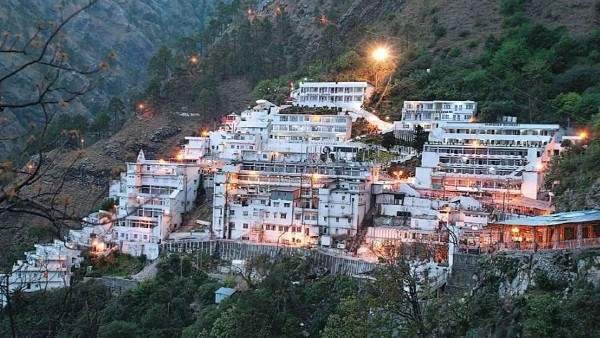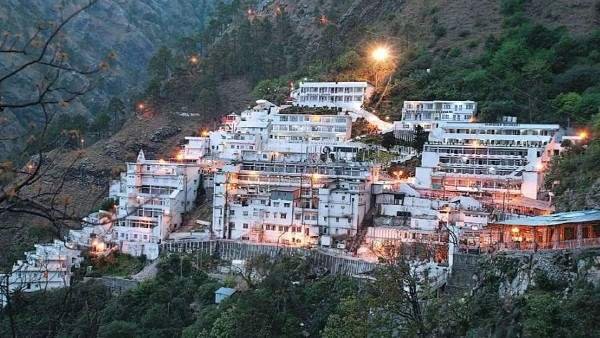Shri Mata Vaishno Devi Temple is revered as one of the holiest sites in India and holds the title of a Shakti Peetha, a place where the Goddess’s spiritual power is worshipped in her fullest form. The temple’s importance lies not only in its religious significance but also in its association with wish fulfillment, peace, and divine intervention. Its location at a significant height, nestled in the lap of the Himalayas, and its aura of mystical legends make it among the most visited temples in Vaishno Devi, Jammu.
History and Legends of Vaishno Devi
The history of Shri Mata Vaishno Devi Temple traverses the lanes of Hindu mythology and local folklore. Mata Vaishno Devi’s origin is believed to be as Vaishnavi, a divine energy created to restore Dharma on earth. She is described as a manifestation of the combined energies of Goddess Mahakali, Mahalakshmi, and Mahasaraswati.
One of the most prominent legends tells of Goddess Vaishnavi’s devotion to Lord Rama, whom she vowed to eternally follow in the path of righteousness. Her journey culminated in the caves of Trikuta Hills, where she sought refuge from Bhairon Nath, a tantric who pursued her. After a climactic battle inside the cave, she revealed her supreme form and vanquished Bhairon Nath, granting him salvation. The Bhairon Temple at the hill’s summit is a testimony to this legend and forms an essential part of the pilgrimage.
The discovery of the cave itself is attributed to Pandit Sridhar, a devout Brahmin who dreamt of the Goddess guiding him to her hidden abode. On following his vision, he found the holy cave with its unique natural rock formations, the Pindis, symbolizing the three forms of the Goddess. These sacred Pindis are the focus of worship and are considered spiritually charged with the divine energy of Vaishno Devi.
Location and Geography
Perched at about 5,200 feet above sea level, Shri Mata Vaishno Devi Temple is cradled by the picturesque Trikuta Hills, with the nearest town being Katra, some 13 kilometers away by foot from the shrine. The region is characterized by lush forests, mountain streams, and panoramic vistas, especially striking during spring and autumn. These seasons offer the most pleasant conditions for pilgrimage, while winters are chilly and monsoons may witness heavy rainfall, making the trek more challenging.
The Holy Cave and the Darshan Route

The central sanctum, or the Holy Cave, enshrines three natural rock formations known as Pindis, each one representing Mahakali, Mahalakshmi, and Mahasaraswati. The pilgrimage, or yatra, begins from Katra, where devotees receive a mandatory yatra slip and set out on a 13-kilometer trek to the Bhawan (temple precincts). Along the way, pilgrims encounter significant stops such as Ban Ganga, Charan Paduka, and Ardhkuwari.
Ardhkuwari Cave, also called Garbha Joon, holds immense spiritual meaning as the spot where Mata Vaishno Devi meditated for nine months, akin to a womb. Pilgrims cherish this site as an embodiment of transformation and birth.
The trek can be completed on foot; however, ponies, palkis, battery cars, a new smooth track, as well as a helicopter service from Katra to Sanjichhat, are available for convenience. Additionally, a ropeway connects Bhawan with the Bhairon Temple, especially helpful for those unable to manage steep ascents.
How to Reach Vaishno Devi Temple
Pilgrims can reach Shri Mata Vaishno Devi Temple with ease via multiple travel options:
- By Air: The closest airport is Jammu, around 50 kilometers from Katra, with frequent taxis and buses running between the two points.
- By Train: Katra Railway Station has direct trains connecting major Indian cities, making the journey hassle-free and comfortable.
- By Road: National highways link Katra to Jammu and other northern cities, with frequent bus, taxi, and private vehicle options available.
Before commencing the trek, devotees must register at the Yatra Registration Counter in Katra, ensuring smooth management and entry at various check posts.
Accommodation and Facilities
Accommodations are plentiful near Katra and along the route to Bhawan, ranging from budget lodges, midrange hotels, to deluxe stays. The Shrine Board’s guesthouses and dormitories provide hygienic, affordable, and pre-bookable shelters to pilgrims. Food facilities, including vegetarian cafeterias and community kitchens (langars), are set up at regular intervals. Cloakrooms for storing valuables, clean drinking water, and medical centers are available along the trek and at Bhawan, ensuring a safe and comfortable journey for all, especially senior citizens and families with children.
Important Rituals and Festivals
Shri Mata Vaishno Devi Temple upholds a daily routine of sacred rituals. The highlight is the morning and evening aarti, a mesmerizing ceremony performed with lamps, flowers, and devotional chants in the cave. Offerings of coconut, red cloth (chunari), and sweets form an integral part of the rituals.
Major festivals include:
- Navratri: The most grand celebration at the temple, marked by spiritual fervor, music, and a massive influx of pilgrims over nine days.
- Diwali: Celebrated with dazzling lights and special prayers.
- New Year Yatra: Witnesses an increased number of devotees, all wishing to begin the new year with the blessings of Mata Vaishno Devi.
Performing aarti and making offerings at Bhawan is considered deeply auspicious, believed to invoke the direct blessings of the Goddess on her devotees.
Tourist Attractions Near Vaishno Devi

Pilgrimage to Shri Mata Vaishno Devi Temple is often combined with visits to other sacred and scenic spots:
- Bhairon Temple: Reached via ropeway or a final climb, believed necessary to complete the yatra as per traditional lore.
- Ardhkuwari Temple: Known for its cave, symbolizing the Goddess’s period of meditation.
- Charan Paduka: Houses the imprints believed to be Mata Vaishno Devi’s own footprints.
- Sanjichhat View Point: Provides spectacular views of the surrounding hills.
Other nearby places include Ban Ganga, Himkoti, Shivkhori cave shrine, and Dera Baba Banda gurdwara, each enriching the spiritual and cultural journey.
Travel Tips for Pilgrims
A successful yatra to Shri Mata Vaishno Devi Temple requires proper preparation:
- Carry weather-appropriate clothes, sturdy shoes, water bottles, and basic first aid.
- Senior citizens and children should take extra health precautions and rest frequently.
- Advance online booking for helicopter or ropeway facilities is advisable, especially during peak seasons and festivals.
- Follow the temple’s code of conduct, respect ecological guidelines, and avoid carrying restricted items like leather goods or non-vegetarian food.
Conclusion
Visiting Shri Mata Vaishno Devi Temple is a profound spiritual journey, promising inner peace, renewed faith, and the divine blessings of the Mother Goddess. The yatra is not just a pilgrimage but an uplifting adventure through sacred mountains, stories of miracles, and centuries-old traditions. Whether one seeks spiritual solace or experiences the vibrant energy of Indian devotion, Shri Mata Vaishno Devi Temple continues to inspire and transform all who make the journey.
Shri Mata Vaishno Devi Temple FAQ
Q1: Where is Shri Mata Vaishno Devi Temple located?
A: The temple is situated on the Trikuta Hills near Katra, Jammu & Kashmir, at an altitude of about 5,200 feet. The trek from Katra to the Bhawan (main temple premises) is approximately 13 kilometers.
Q2: What is the significance of the temple?
A: Shri Mata Vaishno Devi Temple is considered one of the holiest shrines in Hinduism, dedicated to the Goddess Vaishno Devi, an embodiment of Mahakali, Mahalakshmi, and Mahasaraswati. It is one of the 108 Shakti Peethas and is believed to grant the wishes of devotees.
Q3: How can I reach the temple?
A: Pilgrims can reach Katra by train (Katra Railway Station), by air (Jammu Airport, 50 km away), or by road. From Katra, the yatra begins with a trek or by booking ponies, palkis, battery vehicles, or helicopter services to Sanjichhat.
Q4: Is it necessary to register for the yatra?
A: Yes, every pilgrim must register and obtain a Yatra Slip at Katra or online before starting the journey. The slip is necessary for security and accessing the shrine.
Q5: What are the different routes for the yatra?
A: The main routes are the old track, new track (wider and smoother), helicopter ride from Katra to Sanjichhat, and a ropeway from Bhawan to Bhairon Temple.
Q6: What are the darshan timings and how long does the trek take?
A: The temple is open almost all year. Darshan timings are regulated, and the trek usually takes 5–6 hours. During peak times like festivals, expect heavy crowds and longer durations.
Q7: What facilities are available for pilgrims?
A: Facilities include guesthouses, free and paid accommodation, vegetarian food stalls, cloakrooms, and medical services at various stops along the yatra route and at Bhawan.
Q8: Are there any rituals or special pujas?
A: Daily aarti is performed morning and evening. Special rituals are held during festivals like Navratri and Diwali. Offerings of coconut, chunari, and prasad are common.
Q9: Which are the important festivals celebrated at the temple?
A: Navratri is the most prominent festival, drawing the largest number of devotees. Other festivals include Diwali and New Year Yatra, celebrated with great fervor.
Q10: What are the main attractions near the temple?
A: Besides the Bhawan, important spots include Ardhkuwari Cave (Garbha Joon), Bhairon Temple (must-visit to complete the yatra), Charan Paduka, Himkoti viewpoint, and Sanjichhat.
Q11: Can elderly people or children complete the yatra?
A: Yes, but the trek can be taxing. Services such as ponies, palanquins, battery cars, and helicopter are available. Medical checkups and rest stops are recommended.
Q12: What should I pack for the trip?
A: Carry essentials like ID proof, yatra slip, comfortable and weather-suitable clothes, sturdy shoes, water bottles, basic medicines, and personal care items.
Krishna Mishra writes for Insights of Hinduism, where he shares heartfelt thoughts on festivals, traditions, and the timeless wisdom of Sanatan Dharma. His aim is to keep the essence of Hindu culture alive in a way that feels simple, authentic, and relatable to everyone.


